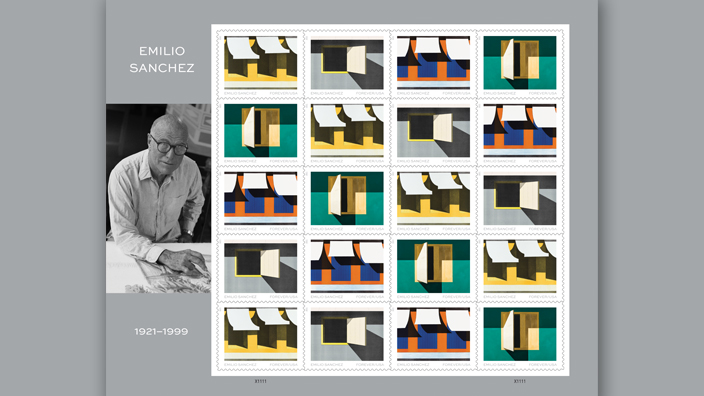The Postal Service released stamps earlier this year to honor Emilio Sanchez. Here are four facts about the pioneering artist.
1. Sanchez’s art was shaped by his Cuban heritage. Sanchez was born in Camaguey, Cuba’s third-largest city, in 1921. In his early 20s, he moved to New York City, where he began his artistic training at the Art Students League. However, it was in Cuba where Sanchez became fascinated by the effects of light and shadow on colored forms, a hallmark of the architectural paintings and lithographs that made him famous.
2. He combined naturalism and abstraction. Sanchez’s work often depicts a single building, with all extraneous details stripped away, although he sometimes highlighted a specific feature, such as a balustrade, arched doorway or balcony. Strong light and deep shadows play across each building’s facade, delineating and emphasizing its abstract geometry without ever obscuring its true character.
3. Sanchez’s source of inspiration expanded as he grew older. His early subjects included houses and other buildings in Mexico, the Caribbean and the United States, where he became a naturalized citizen in 1968. However, he remained especially drawn to Cuban architecture, with its rich mix of Victorian, colonial and rustic rural styles. By the 1970s, Sanchez had widened his focus to include buildings in Morocco and in other Mediterranean countries. He also found continued inspiration in the cityscape of New York, which became more prevalent in his works of the 1980s and 1990s.
4. The Emilio Sanchez stamps feature four of his architectural works. The selections are “Los Toldos”(1973), “Ty’s Place”(1976), “En el Souk”(1972) and “Untitled (Ventanita entreabierta)” (1981). The selvage features a photograph of Sanchez taken in 1993, six years before his death. In the image, Sanchez sketches at the drawing table in his New York City loft studio.
